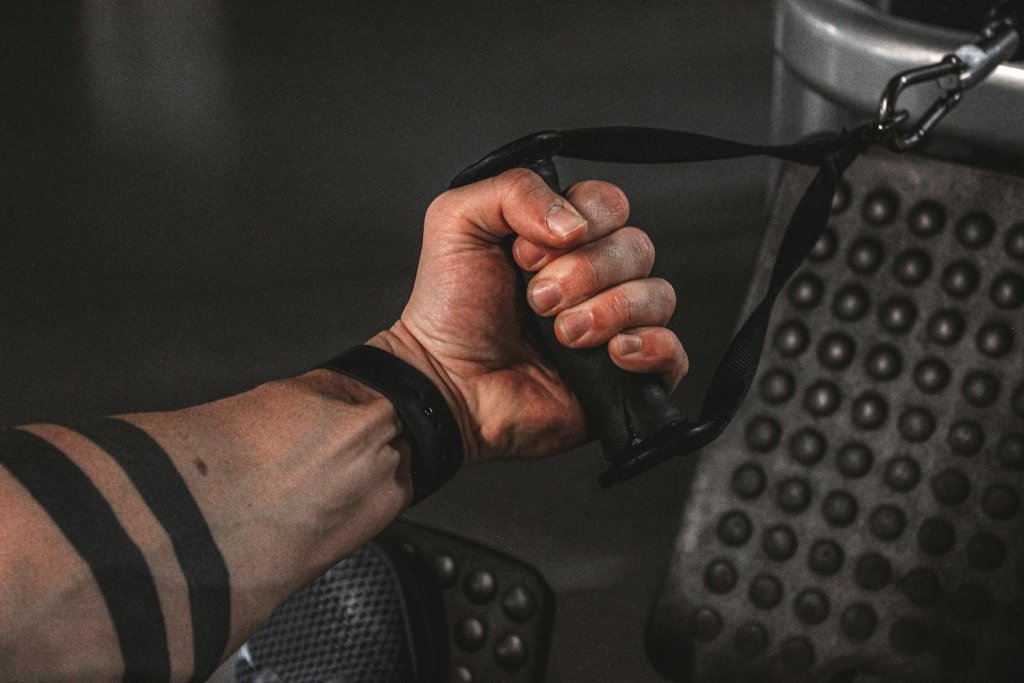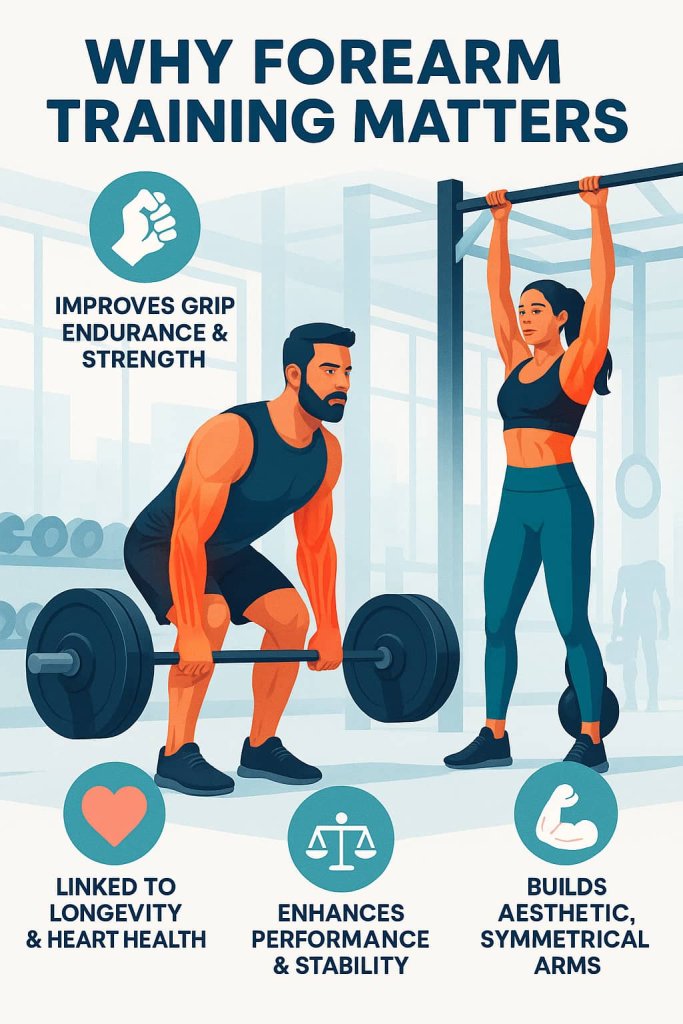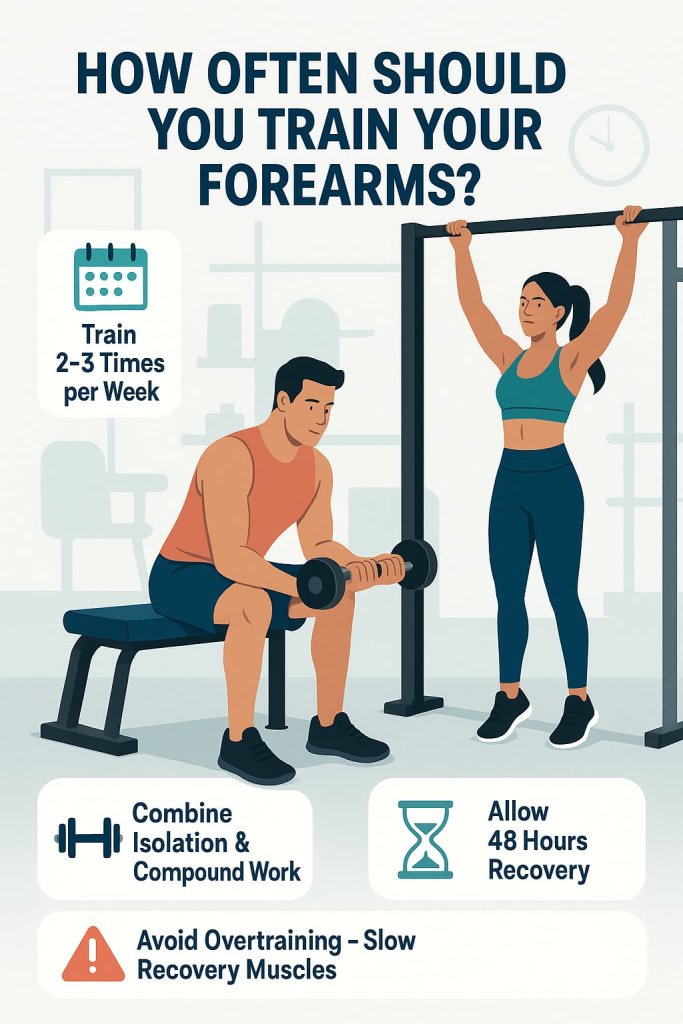Strong forearms aren’t just about looks — they’re the foundation of grip strength, functional performance, and overall upper-body power. Whether you’re lifting heavy, climbing, or improving everyday strength, forearm training enhances endurance, coordination, and aesthetics.

According to a Journal of Strength & Conditioning Research review, consistent forearm and wrist training can improve grip strength by up to 25% in just eight weeks. This guide covers the 15 best forearm exercises backed by research and expert training insight — designed to help you build size, strength, and definition efficiently.
Why Forearm Training Matters
Strong forearms stabilize your wrists and enhance your performance in compound lifts like deadlifts, pull-ups, and rows. Research from Scientific American confirms that grip strength is not only tied to muscle performance but also linked to overall longevity and cardiovascular health.

Benefits include:
- Better grip endurance for heavy lifts
- Improved athletic and functional performance
- Enhanced aesthetics and muscle symmetry
- Reduced risk of wrist and elbow strain
A PubMed study found a 14.9 kg increase in grip strength per 1 cm increase in forearm flexor thickness — proving direct correlation between muscle size and power.
How Often Should You Train Your Forearms?

Train your forearms 2–3 times per week, combining both direct isolation (wrist curls, extensions) and indirect compound work (deadlifts, pull-ups, hammer curls).
Pro Tip: Avoid overtraining — forearms recover slower due to dense muscle fibers. Allow 48 hours between sessions.
15 Best Forearm Exercises
These 15 forearm exercises target every major muscle in your lower arms — from flexors and extensors to grip stabilizers — helping you build balanced strength, power, and definition.
Incorporate them into your weekly routine to enhance grip endurance, prevent injuries, and improve overall upper-body performance.
1. Wrist Curl
Why it works:
This classic isolation exercise directly targets the forearm flexors, promoting muscle growth and grip strength. Controlled wrist curls help increase muscle fiber recruitment and improve wrist stability during heavy lifts.
Muscles worked:
Flexor carpi radialis, palmaris longus, brachioradialis.
How to do it:
- Sit on a flat bench, holding a barbell or dumbbells with palms facing up.
- Rest your forearms on your thighs so that wrists hang just beyond your knees.
- Curl the weight upward using only your wrists, pause at the top, then lower slowly to a full stretch.
Trainer Tip:
Use moderate weight and focus on time under tension — perform 3 sets of 12–15 slow, controlled reps. Avoid using your upper arms for momentum.
2. Reverse Wrist Curl
Why it works:
Balances your wrist and forearm development by training the extensors, often neglected in typical workouts. It improves grip stability and helps prevent overuse injuries.
Muscles worked:
Extensor carpi radialis, extensor digitorum, extensor carpi ulnaris.
How to do it:
- Hold a light barbell or dumbbells with an overhand grip (palms down).
- Rest forearms on your thighs or a flat bench, wrists hanging off the edge.
- Lift the back of your hands toward your forearms, then lower slowly.
Trainer Tip:
Keep range small but tension constant — aim for 3 sets of 15 reps with perfect control.
3. Farmer’s Carry
Why it works:
An unbeatable grip endurance and total-body stability builder that strengthens forearms, traps, and core simultaneously.
Muscles worked:
Forearm flexors and extensors, trapezius, deltoids, core stabilizers.
How to do it:
- Pick up a pair of heavy dumbbells or kettlebells at your sides.
- Stand tall with shoulders back, and walk 30–40 meters at a steady pace.
- Keep your grip tight and core engaged throughout.
Trainer Tip:
Increase load gradually each week. Heavier weights build raw grip power; longer carries improve endurance.
4. Hammer Curl
Why it works:
Builds thick, powerful forearms by engaging the brachioradialis — the key muscle responsible for arm width and grip strength.
Muscles worked:
Biceps brachii, brachialis, brachioradialis.
How to do it:
- Hold dumbbells at your sides with palms facing each other (neutral grip).
- Curl up toward your shoulders while keeping elbows close to your torso.
- Lower slowly with full control.
Trainer Tip:
Slow the lowering phase (eccentric) to maximize muscle activation and growth.
5. Towel Pull-Up
Why it works:
A brutal test of grip and upper-body endurance — engages the entire forearm while also strengthening the lats and biceps.
How to do it:
- Drape two towels over a pull-up bar and grasp one in each hand.
- Pull yourself up until your chin is above the bar, then lower under control.
Trainer Tip:
At the top of each rep, hold for 3–5 seconds to increase grip endurance.
6. Plate Pinch Hold
Why it works:
Enhances pinch grip strength — crucial for improving thumb stability and real-world carrying power.
How to do it:
- Hold two smooth weight plates together between your fingers and thumb.
- Stand upright and squeeze as hard as possible for 30–60 seconds.
Trainer Tip:
Perform 3 rounds per session. Gradually increase plate thickness as your grip improves.
7. Wrist Roller
Why it works:
A dynamic forearm builder that simultaneously challenges both flexors and extensors through continuous tension.
How to do it:
- Stand holding a wrist roller with a rope and weight plate attached.
- Extend arms straight in front of you and roll the bar to lift the weight.
- Reverse direction to slowly lower it.
Trainer Tip:
Go slow and steady — control both directions for maximum muscle burn.
8. Dead Hang
Why it works:
Builds passive grip strength, forearm endurance, and shoulder stability. It also decompresses the spine and improves posture.
How to do it:
- Grab a pull-up bar with an overhand grip and hang freely.
- Keep core tight and shoulders active (don’t shrug). Hold 30–60 seconds.
Trainer Tip:
Increase hold duration weekly to develop powerful grip endurance.
9. Reverse Curl
Why it works:
Engages the brachioradialis and wrist extensors, balancing forearm development and reducing tendon strain.
How to do it:
- Hold an EZ bar or dumbbells with palms facing down.
- Curl up toward your shoulders without moving your elbows.
- Lower slowly and repeat.
Trainer Tip:
Moderate weight and strict form are key — 3 sets of 10–12 reps.
10. Plate Curl
Why it works:
Strengthens smaller stabilizer muscles through a non-traditional grip, improving forearm definition.
How to do it:
- Hold a single weight plate by its edge using both hands.
- Curl it toward your chest while maintaining grip tension.
Trainer Tip:
Focus on squeezing the plate tightly to enhance grip control.
11. Rope Pull
Why it works:
Simulates climbing strength and enhances grip, forearm endurance, and shoulder coordination.
How to do it:
- Attach a rope to a sled, cable machine, or resistance band.
- Pull the rope toward you using a steady, alternating hand-over-hand motion.
Trainer Tip:
Keep the rope taut — don’t let it slack for consistent tension.
12. Zottman Curl
Why it works:
A hybrid exercise combining biceps contraction and forearm control, maximizing arm development.
How to do it:
- Curl dumbbells up with palms facing up.
- Rotate wrists to palms down at the top, then lower slowly.
Trainer Tip:
Lower over 3 seconds for best forearm engagement.
13. Reverse Grip Barbell Row
Why it works:
A compound movement that improves pulling strength while engaging the forearms under heavy tension.
How to do it:
- Hold the barbell underhand, shoulder-width apart.
- Bend slightly at hips, keeping back flat.
- Row the bar to your lower abs, then lower under control.
Trainer Tip:
Keep wrists neutral — avoid hyperextending under heavy load.
14. Sledgehammer Levers
Why it works:
Develops wrist control, rotational strength, and joint stability — vital for athletes and combat sports.
How to do it:
- Grip a sledgehammer at the end of its handle.
- Slowly tilt it side-to-side using wrist control only.
Trainer Tip:
Perform slow, deliberate reps — focus on precision, not speed.
15. Cable Wrist Flexion
Why it works:
Provides constant resistance throughout the range of motion, maximizing muscle growth potential.
How to do it:
- Attach a straight bar to a low pulley.
- Sit or kneel, holding the bar palms-up.
- Curl your wrists toward your forearms and lower slowly.
Trainer Tip:
Use this as a finisher after compound lifts for a complete forearm burnout.
Common Mistakes to Avoid
- Using excessive weight with poor wrist control
- Neglecting wrist extensors (train both sides!)
- Rushing reps — tension time matters most
- Overtraining without proper rest
- Ignoring grip variations (crush, pinch, support)
Sample Forearm Workout Routine
| Exercise | Sets | Reps | Rest |
|---|---|---|---|
| Wrist Curl | 3 | 15 | 45 s |
| Reverse Curl | 3 | 12 | 45 s |
| Farmer’s Carry | 3 | 40 m | 60 s |
| Plate Pinch Hold | 3 | 30 s | 30 s |
| Wrist Roller | 2 | — | — |
Nutrition Tip for Forearm Growth
Muscle gains rely on progressive overload + protein intake.
Aim for 1.6–2.2 g of protein per kg of body weight daily (Morton et al., 2018). Combine resistance training with lean protein (eggs, chicken, lentils) and complex carbs for recovery.
FAQs
1. Do I need direct forearm training if I already lift weights?
Yes — compound lifts help, but isolation work ensures balanced forearm development.
2. How long does it take to see results?
Expect visible improvements within 6–8 weeks of consistent training.
3. Can I train forearms daily?
No — overuse can cause strain. Train 2–3× weekly with rest days.
4. What’s the best exercise for grip strength?
Farmer’s carries and towel pull-ups are top performers for raw grip power.
5. Should I stretch forearms after workouts?
Yes, gentle wrist flexor/extensor stretches prevent tightness and improve mobility.
6. Can women do these exercises?
Absolutely — they build tone and definition without bulk.
7. What equipment do I need?
A pair of dumbbells, a barbell, or resistance bands are enough to start.
Conclusion
Building strong, defined forearms takes consistency — not endless hours. Mix isolation and compound movements, train 2–3× weekly, and focus on form. Within weeks, you’ll notice better grip, thicker forearms, and improved strength across every lift.
Start today — grab the bar, build your grip, and feel the power in every rep.
References
- Grip Strength & Mortality (General Population, 2024) — Stronger grip predicts lower all-cause mortality.
👉 Scientific Reports (Nature) – “Comparison of grip strength measurements for predicting all-cause mortality” - Forearm Size ↔ Grip Strength (Mechanistic Link) — Forearm flexor thickness strongly correlates with handgrip strength (supports hypertrophy work like curls/wrist curls).
👉 PMC – “Handgrip strength dominance is associated with difference in forearm-ulna and -radius muscle thickness” - Training Guidance (Frequency/Progression) — ACSM Position Stand on progressive resistance training (useful for 2–3×/week forearm programming and load progression).
👉 ACSM Position Stand PDF – “Progression Models in Resistance Training for Healthy Adults” - Nutrition for Muscle Gain — Protein meta-analysis shows supplementation (and total intake) enhances strength/size gains; aligns with 1.6–2.2 g/kg guidance.
👉 British Journal of Sports Medicine – “A systematic review, meta-analysis and meta-regression of the effect of protein supplementation on RET gains” - Dead-Hangs / Hangboard Evidence — 8-week randomized comparison of dead-hang protocols improves finger/forearm endurance and strength (supports dead hangs in your list).
👉 PMC – “Comparison of the Effects of Three Hangboard Strength and Endurance Training Programs”
